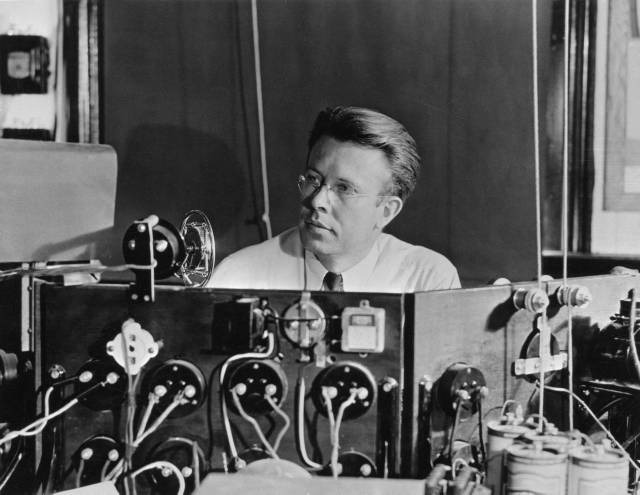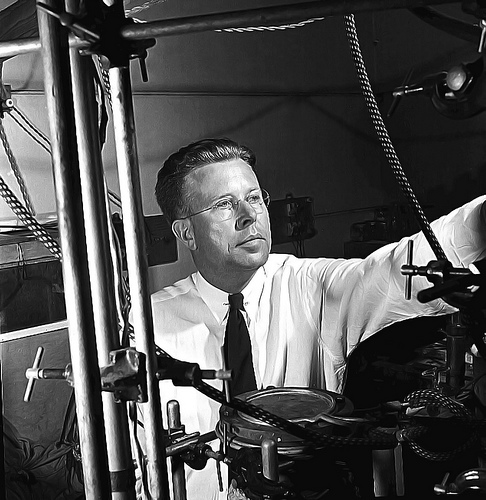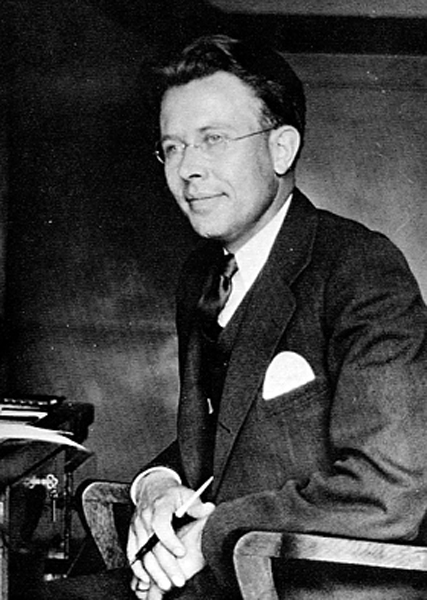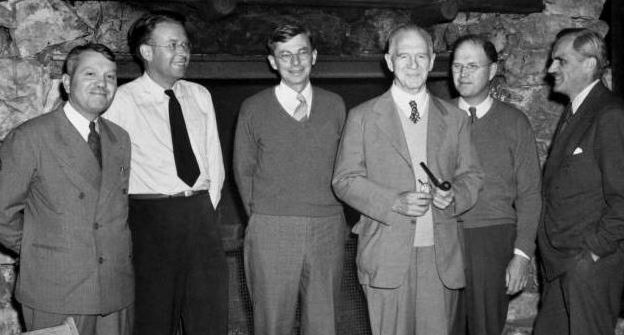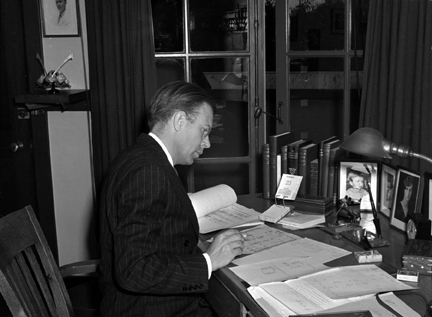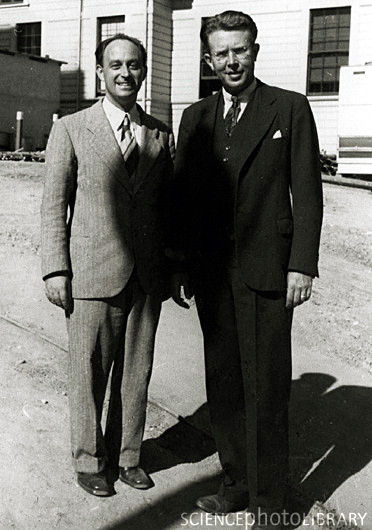<Back to Index>
- Physicist Ernest Orlando Lawrence, 1901
PAGE SPONSOR
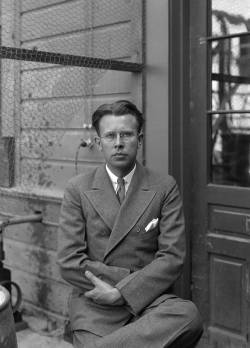
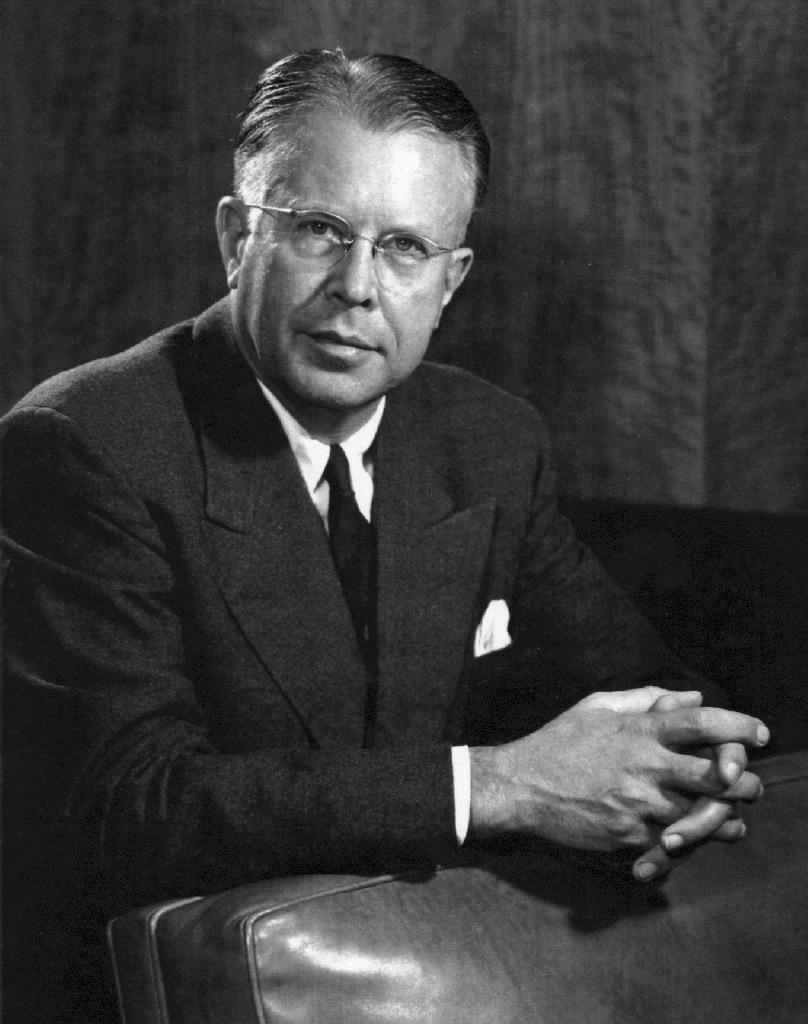

Ernest Orlando Lawrence (August 8, 1901 – August 27, 1958) was an American physicist and Nobel Laureate, known for his invention, utilization, and improvement of the cyclotron atom smasher beginning in 1929, based on his studies of the works of Rolf Widerøe, and his later work in uranium isotope separation for the Manhattan Project. Lawrence had a long career at the University of California, Berkeley, where he became a Professor of Physics. In 1939, Lawrence was awarded the Nobel Prize in Physics for his work in inventing the cyclotron and developing its applications. Chemical element number 103 is named "lawrencium" in Lawrence's honor. He was also the first recipient of the Sylvanus Thayer Award. His brother John H. Lawrence was known for pioneering work in the field of nuclear medicine.
Ernest Orlando Lawrence was born in Canton, South Dakota. His parents, Carl Gustavus and Gunda (née Jacobson) Lawrence, were both the offspring of Norwegian immigrants who had met while teaching at the high school in Canton, South Dakota, where his father was also the superintendent of schools. Growing up, his best friend was Merle Tuve, who would also go on to become a highly accomplished nuclear physicist.
Lawrence attended St. Olaf College in Minnesota, but he transferred to the University of South Dakota after his first year. Lawrence completed his bachelor's degree in 1922. He earned his master's degree in physics from the University of Minnesota in 1923. Next, Lawrence spent a year at the University of Chicago, and then he moved on to Yale University, where he completed his Ph.D. degree in physics in 1925, making him somewhat unusual in his field — a very promising young physical scientist who had received his entire education in the United States. These were years when study at one of the great science institutions of Europe was considered to be essential for anyone who truly wished to make a significant scientific progress. Lawrence remained at Yale University as a researcher, working in the photoelectric effect, and he became an assistant professor there in 1927.
In 1928, Lawrence was hired as an Associate Professor of Physics at the University of California, and two years later he became a full Professor, becoming the youngest Professor at the University of California. There, he was called the "Atom Smasher", and the man who "held the key" to atomic energy. "He wanted to do 'big physics,' the kind of work that could only be done on a large scale with a lot of people involved," said Herbert York, the first director of the Lawrence Livermore laboratory, as quoted on that Laboratory's official Web site.
Robert Gordon Sproul was a member of the Bohemian Club, and he sponsored Lawrence's membership in 1932. Through this club, Lawrence met William Henry Crocker, Edwin Pauley, and John Francis Neylan. They were influential men who helped him obtain money for his energetic nuclear particle investigations.
The
invention that brought Lawrence to international fame started out as a
sketch on a scrap of paper. While sitting in the library one evening,
Lawrence glanced over a journal article and was intrigued by one of the
diagrams. The idea was to produce very high energy particles required for atomic disintegration by
means of a succession of very small "pushes." The device as depicted
however, was laid out in a straight line using increasingly longer
electrodes. Lawrence saw that such an accelerator would
soon become too long and unwieldy for his university laboratory. In
pondering a way to make the accelerator more compact, Lawrence decided
to set a circular accelerating chamber between the poles of an
electromagnet. The magnetic field would hold the charged protons in a
spiral path as they were accelerated between just two semicircular
electrodes connected to an alternating potential. After a hundred turns
or so, the protons would impact the target as a beam of high energy
particles. Lawrence excitedly told his colleagues that he had discovered
a method for obtaining particles of very high energy without the use of
any high voltage. Other scientists, including Leo Szilard, had investigated similar concepts, but Lawrence is credited with developing it further and turning it into practice.
The first model of Lawrence's cyclotron was made out of brass, wire, and sealing wax and was only four inches in diameter — it could literally be held in one hand. It probably cost $25 in all. And it worked: When Lawrence applied 2,000 volts of electricity to his makeshift cyclotron on January 2, 1931, he got 80,000 electron volt protons spinning around (at about 1% the speed of light). Through his increasingly larger machines, Lawrence was able to provide the crucial equipment needed for experiments in high energy physics. Around this device, Lawrence built up his Radiation Laboratory, which would become the world's foremost laboratory for the new field of nuclear physics research in the 1930s. He received a patent for the cyclotron in 1934, which he assigned to the Research Corporation. In 1936 the Radiation Laboratory became an official department of the University of California with Lawrence formally appointed its Director. He served in that capacity until his death. In 1937, he was elected a Fellow of the American Academy of Arts and Sciences.
In November 1939, Lawrence was awarded the Nobel Prize in Physics for his work on the cyclotron,
the first particle accelerator to achieve high energies. Not only was
he the first at Berkeley to become a Nobel Laureate, he was also the
first ever to be so honored while at a state supported university. The
award ceremony was held on February 29, 1940 in Berkeley, California, due to the war, in the auditorium of Wheeler Hall on the campus of the university with Lawrence receiving his medal from Carl E. Wallerstedt, Sweden's Consul General in San Francisco.
During World War II, Lawrence eagerly helped to ramp up the American investigation of the possibility of a weapon utilizing nuclear fission. His Radiation Laboratory (known as the Rad Lab), became one of the major centers for wartime nuclear research, and it was Lawrence who first introduced J. Robert Oppenheimer into what would soon become the Manhattan Project. An early champion of the electromagnetic separation method to enrich uranium and increase its percentage of fissile U-235, Lawrence manufactured his magnetic calutrons — specialized forms of mass spectrometers — for the massive isotope separation plants in Oak Ridge, Tennessee.
Lawrence's secretary, Helen Griggs married the future Nobel Prize in Chemistry winner, Glenn T. Seaborg, in 1942, as the three of them made their way to work on the Manhattan Project in Chicago, Illinois.
After the war, Lawrence campaigned extensively for government sponsorship of large scientific programs. Lawrence was a forceful advocate of "Big Science" with its requirements for big machines and big money.
For his service to his country, Lawrence received the Enrico Fermi Award from the U.S. Atomic Energy Commission in 1957, and was the first recipient of the prestigious Sylvanus Thayer Award by the United States Military Academy in 1958.
In July 1958, President Eisenhower requested that Lawrence travel to Geneva, Switzerland, to help negotiate a proposed treaty with the Soviet Union to ban nuclear weapons testing. Despite suffering from a serious flare - up of his chronic colitis, Lawrence decided to go, but he became ill while in Geneva, and was rushed to the hospital at Stanford University. Lawrence died one month later in Palo Alto, California, at the age of 57.
Just 23 days after his death, the Regents of the University of California voted to rename two of the university's nuclear research sites after Lawrence: the Lawrence Livermore and Lawrence Berkeley Laboratories. The Ernest Orlando Lawrence Award was established in his memory in 1959. Chemical element number 103, discovered at LBNL in 1961, is named "lawrencium" in his honor. In 1968 the Lawrence Hall of Science public
science education center was established in honor of Ernest O.
Lawrence, who had been throughout his career a passionate advocate of
encouraging public interest in science, particularly among
schoolchildren. The museum features a permanent exhibit devoted to
Lawrence's life.
